
 edit
edit
Preface
Blog :【 Red eye aromatherapy blog _CSDN Blog - Computer theory ,2022 Blue Bridge Cup ,MySQL Domain Blogger 】
This article is written by 【 Red eye aromatherapy 】 original , First appeared in CSDN
2022 The greatest wish of the year :【 Serve millions of technical people 】
Python Initial environment address :【Python Visual data analysis 01、python Environment building 】
Environmental requirements
Environmental Science :win10
development tool :PyCharm Community Edition 2021.2
database :MySQL5.6
Catalog
Python Visual data analysis 10、Matplotlib library
Preface
Environmental requirements
Pre environment
Preface
Draw a straight line
plot function
Draw a histogram
Stacked histogram
Draw a side-by-side histogram
Draw histogram
Draw the pie chart
Draw a split pie chart
Draw a scatter plot
draw 3D Images
3D Surface graph
3D Scatter plot
3D Bar chart
pip3 config set global.index-url https://repo.huaweicloud.com/repository/pypi/simplepip3 config listpip3 install --upgrade pippip3 install numpypip3 install matplotlib
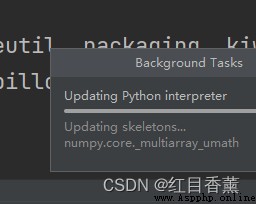
 edit Things are relatively large, and the introduction is slower , Don't worry. .
edit Things are relatively large, and the introduction is slower , Don't worry. .
Matplotlib yes Python One of the most commonly used visualization tools in , It is very convenient to create massive 2D Charts and some basic 3D Chart .
Matplotlib First published in 2007 year , Driven by open source and the community , Now based on Python It has been widely used in various fields of scientific computing .
Matplotlib The most widely used module in is pyplot modular ,pyplot Each drawing function in the module can make some changes to the graph .
import numpy as npfrom matplotlib import pyplot as pltplt.rcParams['font.sans-serif'] = ['SimHei'] # Used to display Chinese labels normally plt.rcParams['axes.unicode_minus'] = False # Used to display negative sign normally x = np.arange(1, 11)y = 2 * xplt.title(" I'm the title ")plt.xlabel(" I am a X Axis ")plt.ylabel(" I am a Y Axis ")plt.plot(x, y)plt.show()
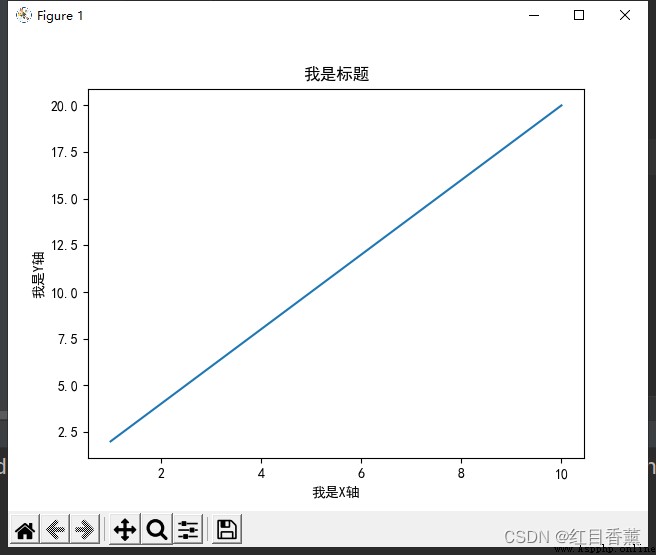
 edit
edit
Irregular value
import numpy as npfrom matplotlib import pyplot as pltplt.rcParams['font.sans-serif'] = ['SimHei'] # Used to display Chinese labels normally plt.rcParams['axes.unicode_minus'] = False # Used to display negative sign normally x = np.arange(1, 11)y = 2 * xplt.title(" I'm the title ")plt.xlabel(" I am a X Axis ")plt.ylabel(" I am a Y Axis ")plt.plot((1, 5, 1, 5, 7, 5, 5, 9, 1, 5), y)plt.show()
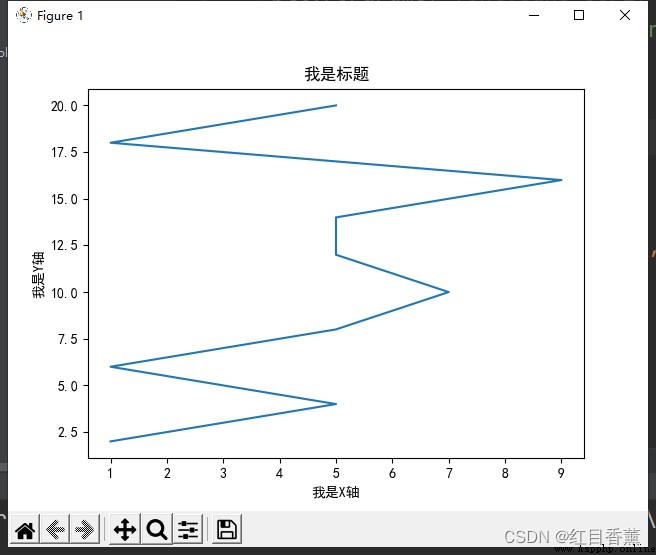
 edit
edit
plot() Functions can pass in multiple parameters , Among them the first 3 Parameters represent the color and type of the line , The first 4 Parameters represent the width of the line
character
meaning
-
Solid line pattern
--
Short horizontal line pattern
-.
Dash pattern
:
Dashed pattern
.
Dot the mark
,
Pixel marker
o
Circle marks
v
Inverted triangle
^
Positive triangle sign
<
Left triangle
>
Right triangle
1
Down arrow mark
2
Up arrow mark
3
Left arrow mark
4
Right arrow mark
s
A square mark
p
Pentagonal sign
*
Star sign
h
Hexagon sign 1
'H'
Hexagon sign 2
+
Plus sign
x
X Mark
D
Diamond mark
'd'
Narrow diamond mark
|
Vertical line marking
_
Horizontal line marking
b
Blue
g
green
r
Red
c
Cyan
m
magenta
y
yellow
k
black
w
white
import numpy as npfrom matplotlib import pyplot as pltplt.rcParams['font.sans-serif'] = ['SimHei'] # Used to display Chinese labels normally plt.rcParams['axes.unicode_minus'] = False # Used to display negative sign normally x = np.arange(1, 11)y = 2 * xplt.title(" I'm the title ")plt.xlabel(" I am a X Axis ")plt.ylabel(" I am a Y Axis ")plt.plot(x, y, "^m")plt.show()
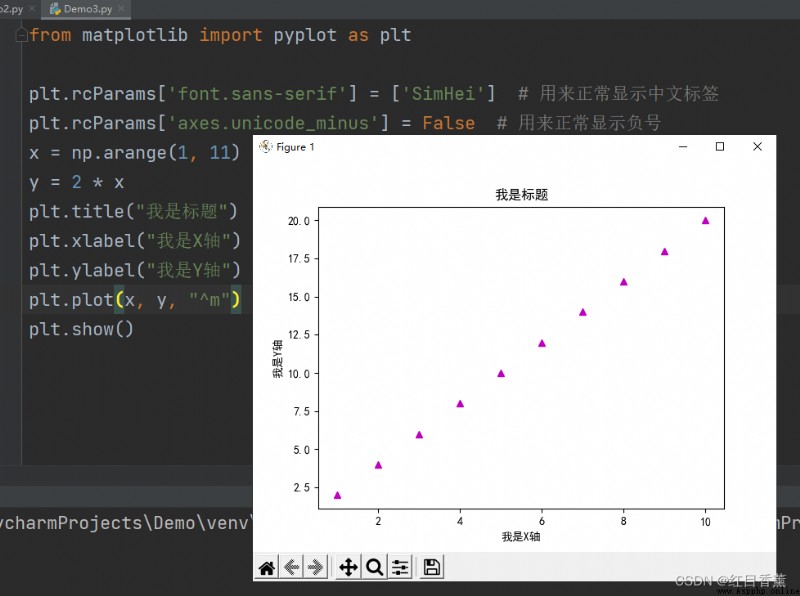
 edit
edit
import numpy as npimport matplotlib.pyplot as pltplt.rcParams['font.sans-serif'] = ['SimHei'] # Used to display Chinese labels normally plt.rcParams['axes.unicode_minus'] = False # Used to display negative sign normally x = ['2018 year ', '2019 year ', '2020 year ', '2021 year ', '2022 year ']y = np.random.randint(0, 100, 5)plt.bar(x, y)plt.title(" Yield change ")plt.show()
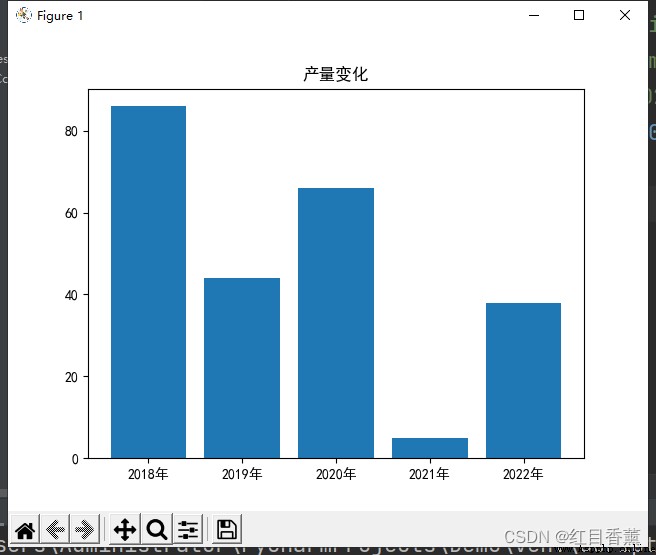
 edit
edit
import numpy as npimport matplotlib.pyplot as pltplt.rcParams['font.sans-serif'] = ['SimHei'] # Used to display Chinese labels normally plt.rcParams['axes.unicode_minus'] = False # Used to display negative sign normally x = ['2018 year ', '2019 year ', '2020 year ', '2021 year ', '2022 year ']y1 = np.random.randint(10, 20, 5)y2 = np.random.randint(10, 20, 5)plt.bar(x, y1)plt.bar(x, y2, bottom=y1)plt.ylabel(" yield ( Trillion tons )")plt.legend(labels=[" food ", " Wheat "], loc="upper left")plt.show()
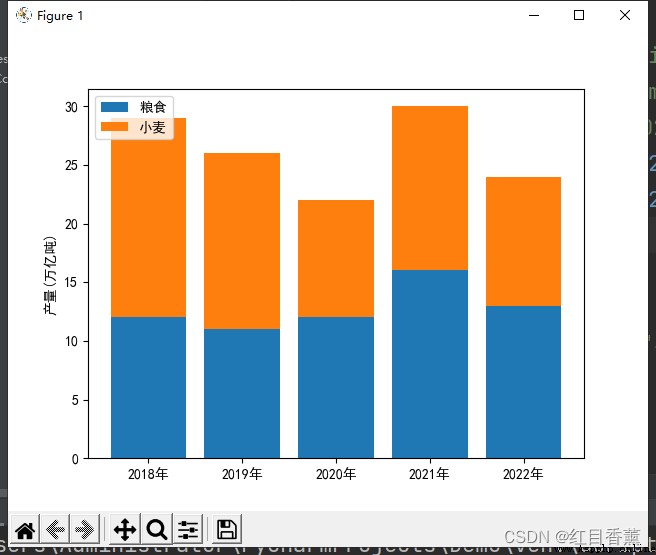
 edit
edit
import numpy as npimport matplotlib.pyplot as pltplt.rcParams['font.sans-serif'] = ['SimHei'] # Used to display Chinese labels normally plt.rcParams['axes.unicode_minus'] = False # Used to display negative sign normally x1 = np.arange(5)y1 = np.random.randint(10, 20, 5)y2 = np.random.randint(10, 20, 5)bar_width = 0.35plt.bar(x1, y1, bar_width)plt.bar(x1 + bar_width, y2, bar_width)plt.ylabel(" yield ( Trillion tons )")tick_label = ['2018 year ', '2019 year ', '2020 year ', '2021 year ', '2022 year ']plt.xticks(x1 + bar_width / 2, tick_label)plt.legend(labels=[" food ", " Wheat "], loc="upper left")plt.show()

 edit
edit
import numpy as npimport matplotlib.pyplot as pltimport randomplt.rcParams['font.sans-serif'] = ['SimHei'] # Used to display Chinese labels normally plt.rcParams['axes.unicode_minus'] = False # Used to display negative sign normally a = [random.randint(80, 150) for i in range(250)]print(a)print(max(a) - min(a))# Count groups d = 3 # Group spacing num_bins = (max(a) - min(a)) // d# Set graphic size plt.figure(figsize=(20, 8), dpi=80)plt.hist(a, num_bins)# Set up x Axis scale plt.xticks(range(min(a), max(a) + d, d))# set grid plt.grid(alpha=0.4)plt.show()
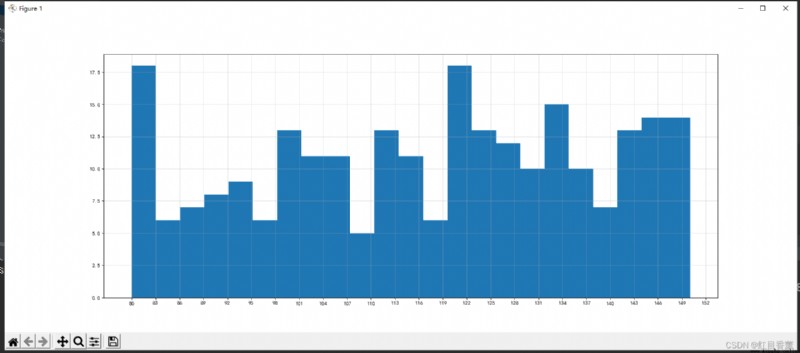
 edit
edit
import numpy as npimport matplotlib.pyplot as pltplt.rcParams['font.sans-serif'] = ['SimHei'] # Used to display Chinese labels normally plt.rcParams['axes.unicode_minus'] = False # Used to display negative sign normally labels =['2018 year ', '2019 year ', '2020 year ', '2021 year ', '2022 year ']y = np.random.rand(5)plt.pie(y, labels=labels, autopct="%3.1f%%", startangle=45, # First slice rotation angle shadow=True, pctdistance=0.8, labeldistance=1.2)plt.show()

 edit
edit
import numpy as npimport matplotlib.pyplot as pltplt.rcParams['font.sans-serif'] = ['SimHei'] # Used to display Chinese labels normally plt.rcParams['axes.unicode_minus'] = False # Used to display negative sign normally labels =['2018 year ', '2019 year ', '2020 year ', '2021 year ', '2022 year ']y = np.random.rand(5)plt.pie(y, explode=(0.1, 0.1, 0.1, 0.1, 0.1), # Percentage of edge deviation from diameter labels=labels, autopct="%3.1f%%", startangle=45, # First slice rotation angle shadow=True, pctdistance=0.8, labeldistance=1.2)plt.show()
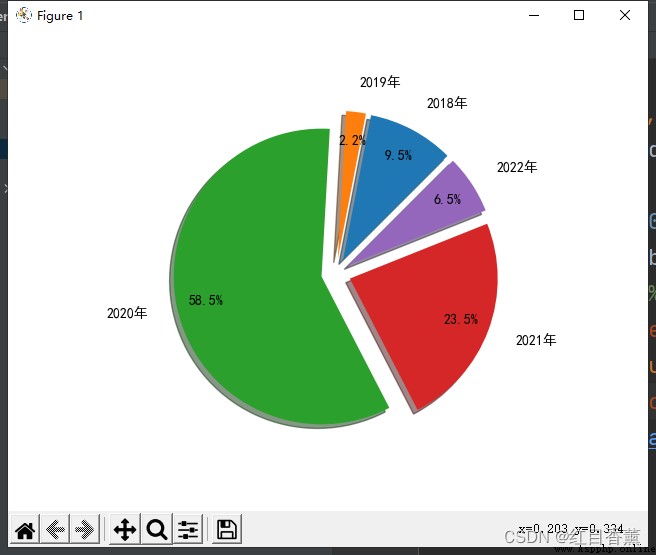
 edit
edit
Scatter diagram is also called scatter distribution diagram , It takes a feature as the abscissa , Take another feature as ordinate , Using coordinate points ( Scatter ) The distribution form of reflects the statistical relationship between characteristics .
Scatterplot can provide two kinds of key information :
Whether there is a numerical or quantitative correlation trend between features , Is the correlation trend linear or nonlinear
If a point or several points deviate from most points , Then these points are outliers , We can further analyze whether these outliers have a great impact on modeling analysis
import numpy as npimport matplotlib.pyplot as pltplt.rcParams['font.sans-serif'] = ['SimHei'] # Used to display Chinese labels normally plt.rcParams['axes.unicode_minus'] = False # Used to display negative sign normally x = np.arange(0, 100)y = np.random.normal(1, 20, 100)plt.scatter(x, y, label=' Coordinates ', color='k', s=25, marker="o")plt.xlabel('X Axis ')plt.ylabel('Y Axis ')plt.title(' title ')plt.legend()plt.show()
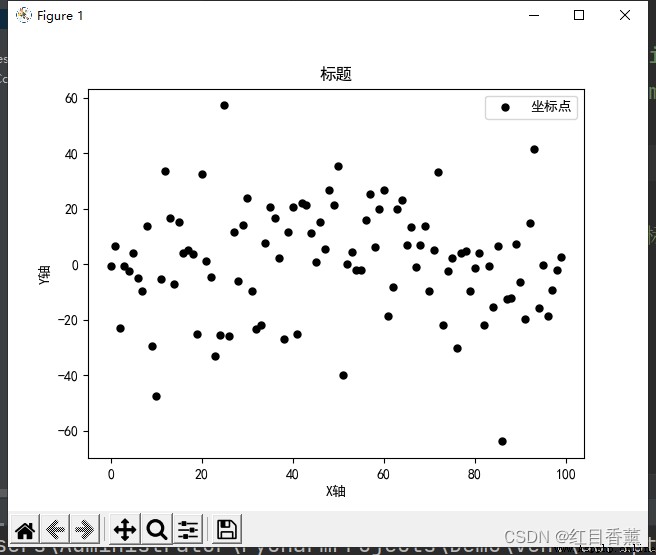
 edit
edit
import numpy as npimport matplotlib.pyplot as pltfrom mpl_toolkits.mplot3d import Axes3Dplt.rcParams['font.sans-serif'] = ['SimHei'] # Used to display Chinese labels normally plt.rcParams['axes.unicode_minus'] = False # Used to display negative sign normally fig = plt.figure() # Use figure object ax = Axes3D(fig) # establish 3D Axis objects X = np.arange(-2, 2, 0.1) # X Coordinate data Y = np.arange(-2, 2, 0.1) # Y Coordinate data X, Y = np.meshgrid(X, Y) # Calculation 3 Dimension surface grid coordinates # Used to calculate X/Y Corresponding Z value def f(x, y): return (1 - y ** 5 + x ** 5) * np.exp(-x ** 2 - y ** 2)# plot_surface() Function to draw the corresponding surface ax.plot_surface(X, Y, f(X, Y), rstride=1, cstride=1)plt.show() # The graphics 
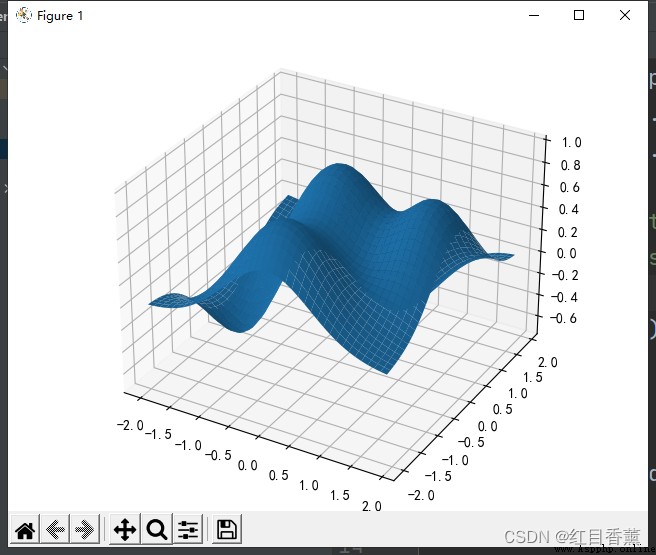
 edit
edit
import numpy as npimport matplotlib.pyplot as pltfrom mpl_toolkits.mplot3d import Axes3Dplt.rcParams['font.sans-serif'] = ['SimHei'] # Used to display Chinese labels normally plt.rcParams['axes.unicode_minus'] = False # Used to display negative sign normally xs = np.random.randint(30, 40, 100)ys = np.random.randint(20, 30, 100)zs = np.random.randint(10, 20, 100)xs2 = np.random.randint(50, 60, 100)ys2 = np.random.randint(30, 40, 100)zs2 = np.random.randint(50, 70, 100)xs3 = np.random.randint(10, 30, 100)ys3 = np.random.randint(40, 50, 100)zs3 = np.random.randint(40, 50, 100)fig = plt.figure()ax = Axes3D(fig)ax.scatter(xs, ys, zs)ax.scatter(xs2, ys2, zs2, c='r', marker='^')ax.scatter(xs3, ys3, zs3, c='g', marker='*')ax.set_xlabel('X label')ax.set_ylabel('Y label')ax.set_zlabel('Z label')plt.show()
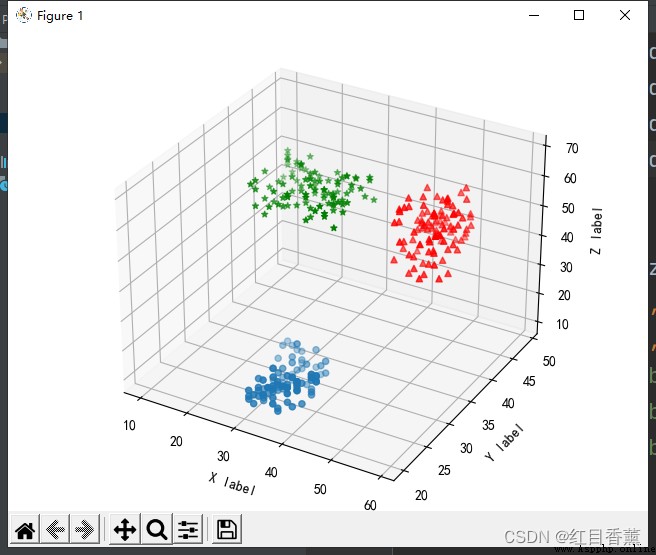
 edit
edit
import numpy as npimport matplotlib.pyplot as pltfrom mpl_toolkits.mplot3d import Axes3Dplt.rcParams['font.sans-serif'] = ['SimHei'] # Used to display Chinese labels normally plt.rcParams['axes.unicode_minus'] = False # Used to display negative sign normally x = np.arange(8)y = np.random.randint(0, 10, 8)y2 = y + np.random.randint(0, 3, 8)y3 = y2 + np.random.randint(0, 3, 8)y4 = y3 + np.random.randint(0, 3, 8)y5 = y4 + np.random.randint(0, 3, 8)clr = ['red', 'green', 'blue', 'black', 'white', 'yellow', 'orange', 'pink']fig = plt.figure()ax = Axes3D(fig)ax.bar(x, y, 0, zdir='y', color=clr)ax.bar(x, y2, 10, zdir='y', color=clr)ax.bar(x, y3, 20, zdir='y', color=clr)ax.bar(x, y4, 30, zdir='y', color=clr)ax.bar(x, y5, 40, zdir='y', color=clr)ax.set_xlabel('X label')ax.set_ylabel('Y label')ax.set_zlabel('Z label')plt.show()

 edit
edit
 Python-Level1-day02: Basic operations on data: variables and their memory map, core data types, operators
Python-Level1-day02: Basic operations on data: variables and their memory map, core data types, operators
1.獲取資源 2.The code execution p
 Python question brushing - bit operation, zip (* \u) Small applications of
Python question brushing - bit operation, zip (* \u) Small applications of
1. Use XOR operation to simpli